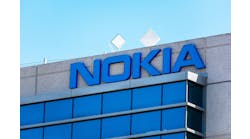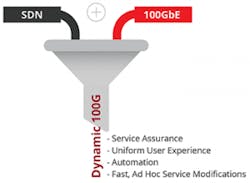How 100GbE and SDN Must Mix in a Hyper-Connected Market —
Bigger. Faster. Dynamic.
Today’s data services are growing in volume, speed, and automation capabilities, in a race to keep pace with exploding data traffic, expanding enterprise networks, and hyperscale data center evolution.
Add to that the impending 5G rollouts, which also require always-on connectivity at high speeds. And then there is IoT, one of 5G’s key drivers, bringing enhanced interconnectedness and coverage for increasingly more "Things" — from Smart Meter concentrators to traffic control systems to millions upon millions of sensors of all types.
In fact, in 2 years, annual global Cloud IP traffic is forecast to reach 19.5 zettabytes. This rise in capacity needs will exert tremendous pressure on the edge, and will necessitate highly sustainable demarcation and aggregation platforms capable of providing flexible service delivery and assurance at ultra-high bandwidths.
In parallel, the accelerated adoption of software defined networking (SDN) and a service-oriented approach to network management have introduced new demands for service automation capabilities, network orchestration, and end-to-end provisioning. This is typically achieved via network service abstraction from the underlying infrastructure, separation of control and data planes, and the use of the NETCONF protocol and YANG modelling language for network-wide management.
Such capabilities were originally developed with network function virtualization (NFV) in mind, but they are now finding their way to Carrier Ethernet services as well. This approach is also reflected in the new MEF 3.0 services framework of standards, which are being defined to "provide an on-demand, cloud-centric experience with unprecedented user- and application-directed control over network resources and service capabilities."
MEF 3.0 has introduced novel concepts, such as life cycle service orchestration (LSO) APIs, as part of its vision to enable dynamic services that are orchestrated over programmable networks.
Where these 2 trends meet has the greatest effect on communications service providers (CSPs). For obvious reasons, providers are the first to implement high-speed technologies to offset the impact on their networks of the massive compute resources of today’s data center Clouds. For them, 100G is already the norm, only now it is coupled with a new set of requirements to better cater to their customers’ business goals.
InvisiLight® Solution for Deploying Fiber
April 2, 2022Go to Market Faster. Speed up Network Deployment
April 2, 2022Episode 10: Fiber Optic Closure Specs Explained…
April 1, 2022Food for Thought from Our 2022 ICT Visionaries
April 1, 2022Dynamic 100G: A New Breed of Services
Service assurance has become ever more important to ensure the iron-clad service level agreements (SLAs) that CSPs’ customers, particularly enterprises, expect. For CSP operations, this translates to an arsenal of much needed tools such as enhanced diagnostics, fine-grained SLA enforcement, and accurate performance monitoring.
CSP operations call for a uniform user experience over the entire network and service path for configuration, administration, and maintenance. They also need a comprehensive zero-touch provisioning (ZTP) process to enable network and service automation by allowing devices to on-board automatically and securely, while minimizing the risk of human errors and reducing OpEx. Such tools also factor into CSPs’ abilities to better compete through service rollouts that are faster than ever.
Another service aspect that has come to be expected by enterprise customers is the ability to quickly modify service parameters, ideally via a self-service portal, to support changing needs. This might include a temporary increase in bandwidth in specific branch locations, adding a new quality of service tier to their service package, or immediately upgrading security as a new threat is identified.
At the back end, this is where SDN comes into play through open APIs towards the higher-level control and orchestration layers, allowing network-wide service modifications to be activated with a mouse click.
Top 3 Use Cases of Dynamic 100G
Here are the leading current use cases for the services that CSPs offer.
Current Use Case #1
Enterprise Business Services
As enterprises move their data centers to the Cloud, they need higher-bandwidth Cloud access services with assured SLAs. Campuses and headquarter sites also need higher capacity and service agility.
In addition, an increasing number of CSPs are adopting multi-tenant service models. In this context, dynamic 100G Carrier Ethernet with multi-tenant capabilities allows traffic from different branches and business customers to be aggregated and demarcated without requiring additional dedicated equipment at each customer’s premises.
At the same time, multiple separate VPNs can be securely delivered with differentiated classes of service.
Current Use Case #2
Inter-Carrier Connectivity
Business service features must also be available outside of the CSPs’ own footprints, over network connections leased from wholesale providers to extend service reach to remote or international locations. Specifically, the external network to network interface (E-NNI) interconnect, the reference point for the boundary between 2 operator networks, requires scalable and dynamic service attributes at high capacity.
Another typical application is hybrid private/public Cloud hosting.
Current Use Case #3
Mobile xHaul
The reality of near-perfect user experience across different devices coupled with the rise in consumption of video/interactive content (such as video streaming and webcasts) results in a massive growth in mobile traffic. Current predictions put monthly global mobile data traffic at 49 exabytes in 2021, growing by an average of 47% each year until then. It amounts to a "data tsunami" as the changing ways in which we consume that data require much higher bandwidth, greater service assurance, ultra-low latency, on-demand flexibility, and automated control. This will become even more crucial as 5G kicks in over the next few years.
Going Forward
100GbE offers service providers a viable solution to cope with the challenges of handling such a high volume of IoT, video, and interactive traffic, in an efficient and economical manner, while saving resources and space. But speed must be coupled with advanced SDN automation capabilities to help CSPs in their network transformation. This is highly important considering the shift to a service-oriented approach to network management and the adoption of the MEF 3.0 services framework.
The forecasts of global Cloud and IP traffic and the consequent pressure on the edge will likely drive such requirements in enterprise business services, wholesale carrier-to-carrier interconnect and mobile backhaul, especially as 5G takes root.
The combination of higher capacity and agility for Cloud-centric services defines the new breed of Ethernet access devices (EADs) that enable flexible service delivery and assurance at ultra-high bandwidths.











